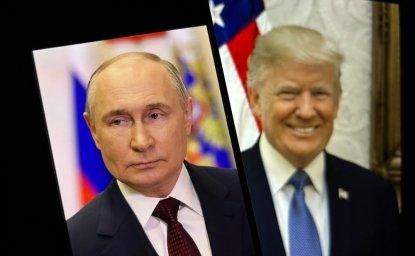The Architectural Scene in Present-Day Moscow

Norwegian writer Knut Hamsun once described Moscow as a magic city that outshone anything he had ever dreamed of. Similarly, Belgian poet Emile Verhaeren referred to the Kremlin in Moscow as "the most beautiful of all the greatest scenes of present times."
These impressions of Moscow date back to the beginning of the 20th century. At that time, Moscow was considered by many to be a spectacular wonder and, architecturally, one of the most interesting cities in Europe.
How has Moscow changed its aesthetic appearance ever since? What tragedies were played out on its grand architectural scene? What is the Moscow of today and what image will it take on tomorrow? These were the questions that Dmitrii Shvidkovskii, Rector, Moscow Institute of Architecture, addressed at a Kennan Institute Alumni Seminar that took place in Moscow on March 19, 2009.
Unfortunately, the Moscow of the beginning of the 20th century that captivated Hamsun and Verhaeren, no longer exists, admitted the speaker. These days, Shvidkovskii put forth, attempts can be made to improve city planning, to make living in the city more convenient, and to solve numerous social problems inherent to a megapolis, yet to render back to Moscow any degree of its lost aesthetic appearance is impossible.
This is the result of the various radical historical transformations that took place in Moscow and in Russia overall. At each stage of history, Moscow architecture truthfully reflected the changing reality.
Shvidkovskii also pointed out the dualistic nature of Moscow's appearance in different periods of its post-revolution history. On one hand, in the 1920s, Moscow was rife with overpopulated, shared "communal" apartments that gradually degraded city living space – a complete architectural phenomenon in itself. On the other hand, this Moscow was also a shinning utopia of the architectural avant-garde that enriched the city with unique constructions, which today are counted among the world's best architectural legacies.
Moscow during Stalin's rule, in Shvidkovskii's view, represents an example of massive loss; the destruction of churches, monasteries, private mansions and gardens was rampant. At the same time, perhaps, Stalin's Moscow also represents an example of the last grand period of classicism in the history of world architecture.
In the times of Khrushchev's détente, the evolved image of Moscow was again dualistic and controversial. From one perspective, one observes freshness, attractiveness, and a laconic poeticism in many of the works of the time, such as the House of Pioneers on Lenin Hills. From another perspective, the 1960s brought about the fall of city suburbs, which were replaced with uniform, multi-stored building complexes. This was also the time of the burning question of how the core of the city should change to reflect the prospective imminent fruition of a truly communist society. All new construction in the historic part of Moscow was called to betoken the forthcoming social changes. As a result, the urban downtown district went through one of the greatest transformations in its entire history: practically half of the Kremlin was destroyed; the Kremlin Palace of Congresses and the Rossiia Hotel were built, the Zariade historical district became crammed and overdeveloped; and newly constructed buildings of light-colored brick spread all over Moscow like a cancer.
According to the speaker, when the Soviet empire approached its fall, its capital still retained its rather well-preserved historic central part, but its appearance was largely dominated by the alarming uniformity of recent building complexes. The last decade of the 20th century saw another key stage in Moscow's image transformation. City architecture was changing drastically, reflecting quite accurately the new direction of history. The streets started to be filled with the merchant crowd and later, with the invariable kiosks that brought about a completely different rhythm to Moscow urban space.
The present-day appearance of the city yet again exhibits dualistic features, according to Shvidkovskii. On one hand, there is a false "new historicism," by which architectural monuments are restored like new. On the other hand, one observes totally commercialized, characterless architecture. The style and décor of new structures in Moscow remain unnoticed, for today no one cares which of the countless modern architectural styles receives preference. Moscow's modern appearance surprises no one anymore. What astounds is only the rapid and total disappearance of the historical heritage and uniqueness of the city.
In Shvidkovskii's opinion, there are many talented architects in Russia today. One could hope that in the course of time a new avant-garde will appear that will bring more vividness and individuality to the city. The current crisis, however, does not allow for it. At present, no avenues for an aesthetic revival of Moscow can be foreseen.
Author
Kennan Moscow Project

Kennan Institute
After more than 50 years as a vital part of the Wilson Center legacy, the Kennan Institute has become an independent think tank. You can find the current website for the Kennan Institute at kennaninstitute.org. Please look for future announcements about partnership activities between the Wilson Center and the Kennan Institute at Wilson Center Press Room. The Kennan Institute is the premier US center for advanced research on Eurasia and the oldest and largest regional program at the Woodrow Wilson International Center for Scholars. The Kennan Institute is committed to improving American understanding of Russia, Ukraine, Central Asia, the South Caucasus, and the surrounding region through research and exchange. Read more

Explore More
Browse Insights & Analysis
The OSCE is a Good Value for America

Infographic | Russia's Illegal Annexation of Crimea

Russia’s Indigenous Communities and the War in Ukraine
